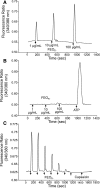Chemical composition and phagocyte immunomodulatory activity of Ferula iliensis essential oils
- PMID: 28258152
- PMCID: PMC5433855
- DOI: 10.1189/jlb.3A1216-518RR
Chemical composition and phagocyte immunomodulatory activity of Ferula iliensis essential oils
Abstract
Essential oil extracts from Ferula iliensis have been used traditionally in Kazakhstan for treatment of inflammation and other illnesses. Because little is known about the biologic activity of these essential oils that contributes to their therapeutic properties, we analyzed their chemical composition and evaluated their phagocyte immunomodulatory activity. The main components of the extracted essential oils were (E)-propenyl sec-butyl disulfide (15.7-39.4%) and (Z)-propenyl sec-butyl disulfide (23.4-45.0%). Ferula essential oils stimulated [Ca2+]i mobilization in human neutrophils and activated ROS production in human neutrophils and murine bone marrow phagocytes. Activation of human neutrophil [Ca2+]i flux by Ferula essential oils was dose-dependently inhibited by capsazepine, a TRPV1 channel antagonist, indicating that TRPV1 channels mediate this response. Furthermore, Ferula essential oils stimulated Ca2+ influx in TRPV1 channel-transfected HEK293 cells and desensitized the capsaicin-induced response in these cells. Additional molecular modeling with known TRPV1 channel agonists suggested that the active component is likely to be (Z)-propenyl sec-butyl disulfide. Our results provide a cellular and molecular basis to explain at least part of the beneficial therapeutic properties of FEOs.
Keywords: calcium flux; molecular modeling; neutrophil; reactive oxygen species; transient receptor potential vanilloid 1 channel.
© Society for Leukocyte Biology.
Figures





Similar articles
-
Modulation of Human Neutrophil Responses by the Essential Oils from Ferula akitschkensis and Their Constituents.J Agric Food Chem. 2016 Sep 28;64(38):7156-70. doi: 10.1021/acs.jafc.6b03205. Epub 2016 Sep 13. J Agric Food Chem. 2016. PMID: 27586050 Free PMC article.
-
Chemical composition, antioxidant and antimicrobial activities of essential oil obtained from Ferula assa-foetida oleo-gum-resin: effect of collection time.Food Chem. 2013 Jun 15;138(4):2180-7. doi: 10.1016/j.foodchem.2012.11.131. Epub 2012 Dec 29. Food Chem. 2013. PMID: 23497874
-
The volatile oils from the oleo-gum-resins of Ferula assa-foetida and Ferula gummosa: A comprehensive investigation of their insecticidal activity and eco-toxicological effects.Food Chem Toxicol. 2020 Jun;140:111312. doi: 10.1016/j.fct.2020.111312. Epub 2020 Apr 2. Food Chem Toxicol. 2020. PMID: 32247803
-
Research Progress of Ferula ferulaeoides: A Review.Molecules. 2023 Apr 19;28(8):3579. doi: 10.3390/molecules28083579. Molecules. 2023. PMID: 37110813 Free PMC article. Review.
-
Metabolic Profile, Bioactivities, and Variations in the Chemical Constituents of Essential Oils of the Ferula Genus (Apiaceae).Front Pharmacol. 2021 Mar 12;11:608649. doi: 10.3389/fphar.2020.608649. eCollection 2020. Front Pharmacol. 2021. PMID: 33776754 Free PMC article. Review.
Cited by
-
Neutrophil Immunomodulatory Activity of Natural Organosulfur Compounds.Molecules. 2019 May 10;24(9):1809. doi: 10.3390/molecules24091809. Molecules. 2019. PMID: 31083328 Free PMC article.
-
Chemical Composition and Antibacterial Activity of Essential Oils from Ferula L. Species against Methicillin-Resistant Staphylococcus aureus.Molecules. 2018 Jul 10;23(7):1679. doi: 10.3390/molecules23071679. Molecules. 2018. PMID: 29996498 Free PMC article.
-
Essential Oils from Monarda fistulosa: Chemical Composition and Activation of Transient Receptor Potential A1 (TRPA1) Channels.Molecules. 2020 Oct 22;25(21):4873. doi: 10.3390/molecules25214873. Molecules. 2020. PMID: 33105614 Free PMC article.
-
The Antioxidant, Anti-Inflammatory and Immunomodulatory Effects of Camel Milk.Front Immunol. 2022 Apr 12;13:855342. doi: 10.3389/fimmu.2022.855342. eCollection 2022. Front Immunol. 2022. PMID: 35493477 Free PMC article. Review.
-
Current Progress and Emerging Role of Essential Oils in Drug Delivery Therapeutics.Curr Drug Deliv. 2025;22(3):332-357. doi: 10.2174/0115672018287719240214075810. Curr Drug Deliv. 2025. PMID: 38409707 Review.
References
-
- Beutler B. (2004) Innate immunity: an overview. Mol. Immunol. 40, 845–859. - PubMed
-
- Witko-Sarsat V., Rieu P., Descamps-Latscha B., Lesavre P., Halbwachs-Mecarelli L. (2000) Neutrophils: molecules, functions and pathophysiological aspects. Lab. Invest. 80, 617–653. - PubMed
-
- Fletcher S., Steffy K., Averett D. (2006) Masked oral prodrugs of toll-like receptor 7 agonists: a new approach for the treatment of infectious disease. Curr. Opin. Investig. Drugs 7, 702–708. - PubMed
-
- Schepetkin I. A., Kirpotina L. N., Khlebnikov A. I., Quinn M. T. (2007) High-throughput screening for small-molecule activators of neutrophils: identification of novel N-formyl peptide receptor agonists. Mol. Pharmacol. 71, 1061–1074. - PubMed
Publication types
MeSH terms
Substances
Grants and funding
LinkOut - more resources
Full Text Sources
Other Literature Sources
Miscellaneous

